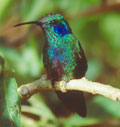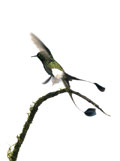Adapted to their method of feeding
 Ruby-throated Hummingbird Archilochus colubrisCredit: Emily Hoyer(Size: 115.28 kb) |
The fact that hummingbirds feed on nectar requires unusual feats: flowers are fragile and sometimes hang downwards. The flight of hummingbirds somewhat resembles that of insects, using upstrokes and downstrokes in their flying. In other birds, downstrokes alone generate the lift to fly. Hummingbirds use 75% downstrokes and 25% upstrokes in their flying. While they are very acrobatic in the air, they are incapable of walking or climbing, their feet being used only for perching.
Hovering
When hovering, a hummingbird's wings, which are pointed and uncambered, move primarily horizontally, tracing a figure eight with the wingtips. By altering the angle of their wings, hummingbirds are able to remain motionless, advance, back up and move side-to-side. When hovering, the wingbeat of small hummingbirds, like the Amethyst Woodstar (Calliphlox amethystina), is 70 to 80 per second, whereas that of larger ones, like the Giant Hummingbird (Patagona gigas), can be 10 to 15 per second. Among the main Canadian species - the Ruby-throated Hummingbird (Archylocus colubris) and the Rufous Hummingbird (Selaphorus rufus) - wingbeats of up to 200 per second during courtship have been recorded.
As fast as lightning
 Green Violet-ear Colibri thalassinusCredit: Jean Léveillé(Size: 65.08 kb) |
The flight speed of certain hummingbirds has been measured in laboratory conditions with recorded speeds varying from 48 to 85 km/hr. In natural settings, the speed of the Green Violet-ear (Hummingbird thalassinus) has been recorded at 96 km/hr and even 150 km/hr over short distances.
The role of the hummingbird's tail
 Booted Racket-tail Ocreatus underwoodiiCredit: Luis Mazariegos(Size: 27.24 kb) |
The tails of hummingbirds vary in size and shape, but they have the same role: to ensure manoeuvrability and control during flight. The tail is used specifically for flying upwards; it also ensures balance and adjustment during sudden changes in direction, and transitions between direct flying and hovering. Hummingbirds have 10 tail feathers, except for the Marvelous Spatuletail (Loddigesia mirabilis) of Peru which has only four. In the adult male of this species, one pair of tail feathers is highly modified; the vertebral column is slightly curved and its extremity is enlarged in the shape of a snowshoe. |

